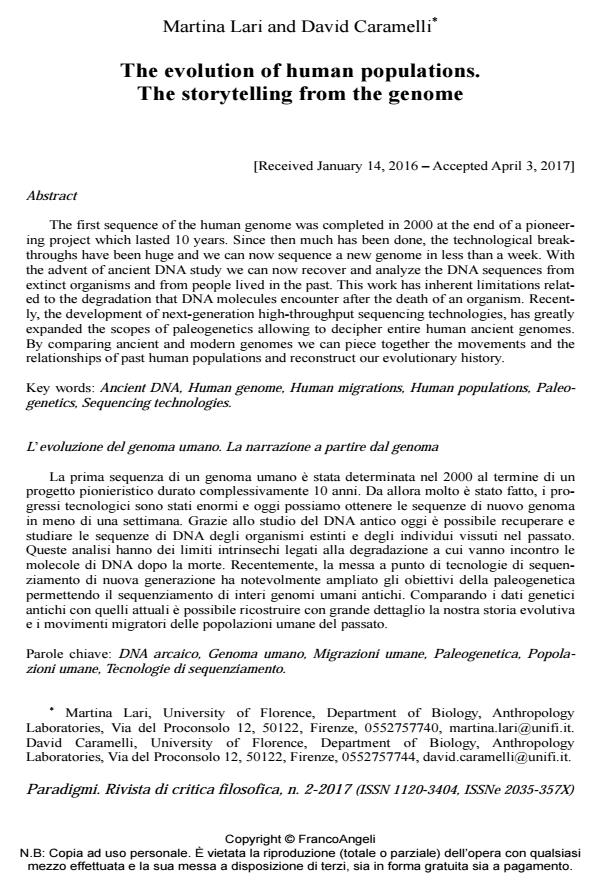The evolution of human populations. The storytelling from the genome
Titolo Rivista PARADIGMI
Autori/Curatori Martina Lari, David Caramelli
Anno di pubblicazione 2017 Fascicolo 2017/2
Lingua Inglese Numero pagine 10 P. 113-122 Dimensione file 147 KB
DOI 10.3280/PARA2017-002008
Il DOI è il codice a barre della proprietà intellettuale: per saperne di più
clicca qui
Qui sotto puoi vedere in anteprima la prima pagina di questo articolo.
Se questo articolo ti interessa, lo puoi acquistare (e scaricare in formato pdf) seguendo le facili indicazioni per acquistare il download credit. Acquista Download Credits per scaricare questo Articolo in formato PDF

FrancoAngeli è membro della Publishers International Linking Association, Inc (PILA)associazione indipendente e non profit per facilitare (attraverso i servizi tecnologici implementati da CrossRef.org) l’accesso degli studiosi ai contenuti digitali nelle pubblicazioni professionali e scientifiche
The first sequence of the human genome was completed in 2000 at the end of a pioneering project which lasted 10 years. Since then much has been done, the technological break-throughs have been huge and we can now sequence a new genome in less than a week. With the advent of ancient DNA study we can now recover and analyze the DNA sequences from extinct organisms and from people lived in the past. This work has inherent limitations related to the degradation that DNA molecules encounter after the death of an organism. Recently, the development of next-generation high-throughput sequencing technologies, has greatly expanded the scopes of paleogenetics allowing to decipher entire human ancient genomes. By comparing ancient and modern genomes we can piece together the movements and the relationships of past human populations and reconstruct our evolutionary history.
La prima sequenza di un genoma umano è stata determinata nel 2000 al termine di un progetto pionieristico durato complessivamente 10 anni. Da allora molto è stato fatto, i pro-gressi tecnologici sono stati enormi e oggi possiamo ottenere le sequenze di nuovo genoma in meno di una settimana. Grazie allo studio del DNA antico oggi è possibile recuperare e studiare le sequenze di DNA degli organismi estinti e degli individui vissuti nel passato. Queste analisi hanno dei limiti intrinsechi legati alla degradazione a cui vanno incontro le molecole di DNA dopo la morte. Recentemente, la messa a punto di tecnologie di sequen-ziamento di nuova generazione ha notevolmente ampliato gli obiettivi della paleogenetica permettendo il sequenziamento di interi genomi umani antichi. Comparando i dati genetici antichi con quelli attuali è possibile ricostruire con grande dettaglio la nostra storia evolutiva e i movimenti migratori delle popolazioni umane del passato.
Parole chiave:DNA arcaico, Genoma umano, Migrazioni umane, Paleogenetica, Popolazioni umane, Tecnologie di sequenziamento.
Martina Lari, David Caramelli, The evolution of human populations. The storytelling from the genome in "PARADIGMI" 2/2017, pp 113-122, DOI: 10.3280/PARA2017-002008